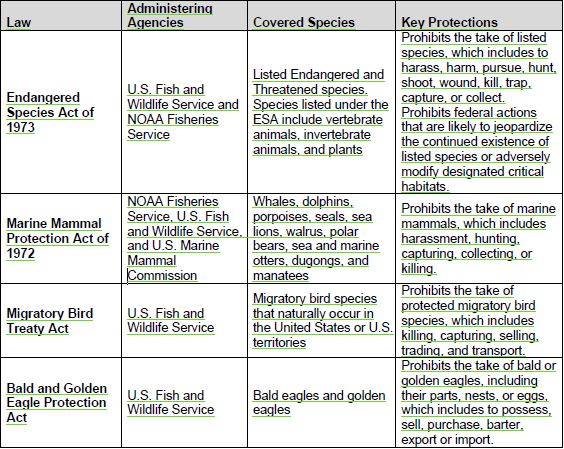The FWS, which with the National Oceanic and Atmospheric Administration (NOAA) has primary responsibility for administration of the ESA, is charged with assessing the condition of plants and animals for the purpose of determining which warrant protection under that Act. For this purpose, the Service seeks to identify those species considered endangered, defined in the Act as “an animal or plant species in danger of extinction throughout all or a significant portion of its range,” and those considered threatened, defined as “an animal or plant species likely to become endangered within the foreseeable future throughout all or a significant portion of its range.”
Overall, 1,666 U.S. species were listed under the Endangered Species Act as of December 2020, of which 1,273 are endangered, and another 393 threatened (FWS 2021b).4 The number of listed species is dynamic, as additional species are considered for possible listing, and other species considered for delisting due either to recovery, extinction, or reassessment of their conservation status. For example, due to the elimination of the pesticide DDT and other conservation practices, bald eagle numbers in the lower 48 states have climbed from a low of 417 nesting pairs in 1963 to well over 10,000 pairs (FWS 2016). Based on this strong recovery, the species was removed (“delisted”) from the federal endangered species list in 2007.5 Species can also be “downlisted” from endangered to threatened in recognition of a sustained improvement in status or a decrease in threats. In October 2020, for example, the FWS proposed that red-cockaded woodpecker be reclassified from “endangered” to “threatened” in recognition of the substantial increase in populations resulting from conservation and species recovery work carried out by federal, state, and private partners, including DoD. In support of that proposal, the Service estimates that about 7,800 active clusters of red-cockaded woodpeckers now exist rangewide, up from about 4,700 active clusters in 1995 (FWS 2020).
4Of the 1,666 listed species, 445 are vertebrate animals, 278 invertebrate animals, and 943 plants.
5Bald eagle safeguards remain in place under the Bald and Golden Eagle Protection Act.
The primary purpose of the endangered species list is to serve as the basis for legal protections and species recovery actions (see Table 1.1 for additional types of federally protected species). As Figure 1.1 shows, the rate of listings under the ESA varies dramatically, reflecting not only the biological condition of plants and animals, but also the availability of funds for listing and delisting activities, as well as shifts in priorities and policies across administrations (Evans et al. 2016). As a result, the federal endangered species list is not a sufficient gauge of the overall condition of the U.S. biota. Indeed, a better overview of the broad condition of U.S. species is offered by the conservation status assessments of the NatureServe Network.

Figure 1.1. Listings under the U.S. Endangered Species Act. The rate at which species have been listed as threatened or endangered under the U.S. Endangered Species Act has varied considerably over time (FWS2021b).
Table 1.1. Federally protected species
Several federal laws provide legal protections for various U.S. species. In addition to these federal laws, many states have enacted their own endangered species and wildlife protection laws.

Next Page: NatureServe Conservation Status Assessments
Author
Bruce Stein, Ph.D., Chief Scientist and Associate Vice President
National Wildlife Federation
State of the Nation: The Condition of Biodiversity Across the United States Sections
State of the Nation: The Condition of Biodiversity Across the United States
How is America’s Biodiversity Faring?
Endangered Species Act Listings
NatureServe Conservation Status Assessments
